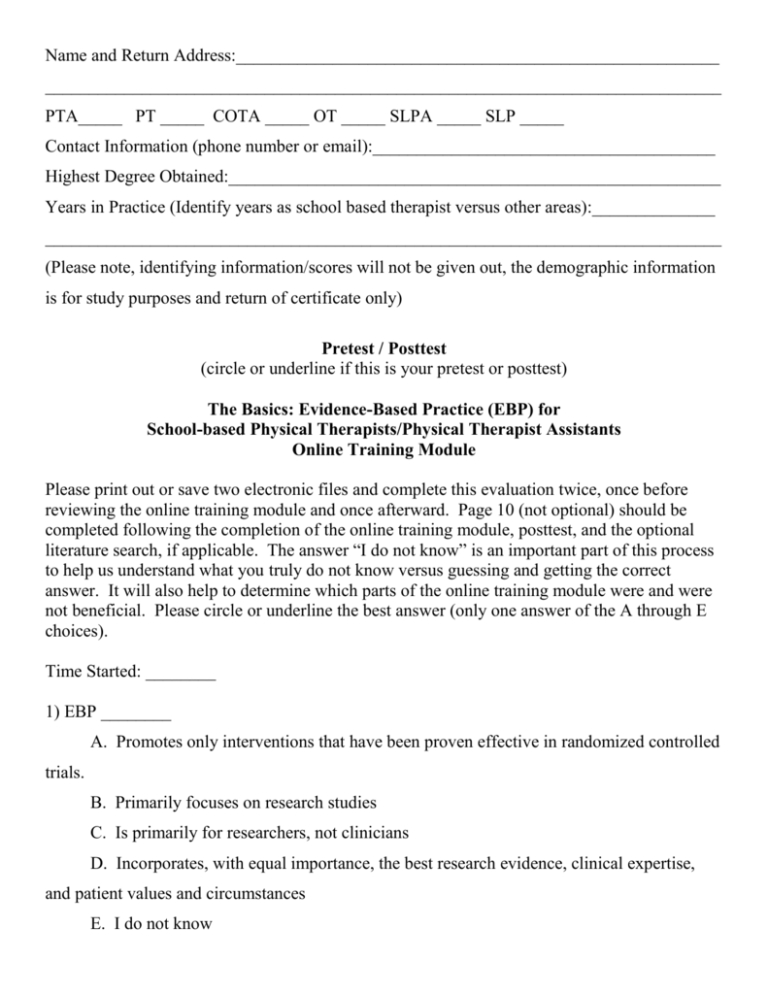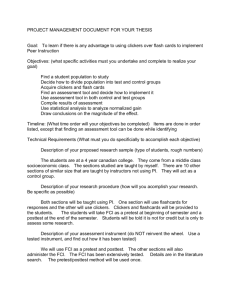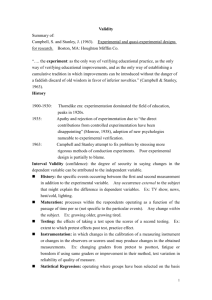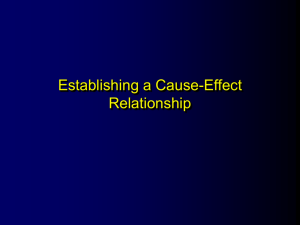Module Pre/Post Test
advertisement

Name and Return Address:_______________________________________________________ _____________________________________________________________________________ PTA_____ PT _____ COTA _____ OT _____ SLPA _____ SLP _____ Contact Information (phone number or email):_______________________________________ Highest Degree Obtained:________________________________________________________ Years in Practice (Identify years as school based therapist versus other areas):______________ _____________________________________________________________________________ (Please note, identifying information/scores will not be given out, the demographic information is for study purposes and return of certificate only) Pretest / Posttest (circle or underline if this is your pretest or posttest) The Basics: Evidence-Based Practice (EBP) for School-based Physical Therapists/Physical Therapist Assistants Online Training Module Please print out or save two electronic files and complete this evaluation twice, once before reviewing the online training module and once afterward. Page 10 (not optional) should be completed following the completion of the online training module, posttest, and the optional literature search, if applicable. The answer “I do not know” is an important part of this process to help us understand what you truly do not know versus guessing and getting the correct answer. It will also help to determine which parts of the online training module were and were not beneficial. Please circle or underline the best answer (only one answer of the A through E choices). Time Started: ________ 1) EBP ________ A. Promotes only interventions that have been proven effective in randomized controlled trials. B. Primarily focuses on research studies C. Is primarily for researchers, not clinicians D. Incorporates, with equal importance, the best research evidence, clinical expertise, and patient values and circumstances E. I do not know 2) What did NC school-based PTs list (with highest frequency) as their primary #1 barrier to searching and using EBP? A. Time B. Difficulty accessing materials C. Uncertainty how to perform search D. Lack of internet access E. I do not know 3) What is one fundamental principle of EBP? (per Guyatt and Rennie) A. “Clinical decision making should be guided by those who know best, expert opinion.” B. “If a study fails to show statistical significance of a treatment, that treatment should not be implemented.” C. “All research studies are of equal relevance and statistical support” D. “Evidence alone is never sufficient to make a clinical decision” E. I do not know 4. What type of research involves manipulation of variables? A. Correlational research B. Cohort study C. Randomized clinical trial D. Case study E. I do not know 5. Which one of these studies listed represents the highest strength of evidence for treatment decisions? A. Summary of several observational studies B. Systematic reviews of randomized trials C. Expert opinion D. Single randomized trial E. I do not know 6. What type of variable is manipulated by the researcher? A. Independent B. Ordinal C. Dependent D. Nominal E. I do not know 7. Pain scales are examples of what type of measurement level? A. Interval B. Dependent C. Ordinal D. Nominal E. I do not know 8. The validity of diagnostic tests is based on ________ A. The application of the test to more than one diagnostic category B. The reproducibility of the test C. The ability of a test to accurately determine the presence or absence of a condition D. The ability of the test to determine prognosis based on severity of the condition E. I do not know 9. A new screening tool your evaluation team plans to use on preschoolers with potential developmental delays has a high sensitivity, but a low specificity. What does this mean? (A positive test = developmental delays) A. It is likely that your team will not miss students with developmental delays, but many may test positive when, in fact, they do not have developmental delays. B. It is likely that your team will miss students with developmental delays, those with negative screening results may have delays. However, those with a positive test are likely to be accurately screened as delayed. C. Those with a positive test are likely to be delayed and those with a negative test are unlikely to be delayed D. Those with a positive test are unlikely to be delayed and those with a negative test are likely to be delayed. E. I do not know 10. Which statistical validity test requires prior calculation of the pretest probability of the condition? A. Sensitivity B. Specificity C. Predictive values D. Likelihood ratios E. I do not know 11. What term is used to denote a clinically meaningful amount of change? A. Effect Size (ES) B. Minimal Clinically Important Difference (MCID) C. Receiver Operating Characteristic (ROC) D. Confidence Interval (CI) E. I do not know 12. What is intrarater reliability? A. Reliability of data collection across various instruments B. Reliability of data collection from one individual over two or more trials C. Reliability of data collection from one subject D. Reliability of data collection between two or more raters E. I do not know 13. Which of these statistics is not a measure of variability? A. Coefficient of Variation B. Range C. Mean D. Variance E. I do not know 14. The larger the standard deviation, the ________ the variable’s scores are surrounding a mean. A. More spread out B. Less spread out C. Higher D. Lower E. I do not know 15. As the sample size, n, increases_____________ A. Confidence in the similarity between sample values and population values decreases B. Standard error of the mean increases C. Confidence in the similarity between sample values and population values increases D. Sampling error increases E. I do not know 16. When the null hypothesis is rejected, the clinician can conclude that ________ A. The effect of treatment is not due to chance B. The study was underpowered C. The statistical hypothesis was accepted D. The alternative hypothesis was rejected E. I do not know 17. When a researcher chooses an α of 0.05, there is a ___________ A. 95% protection against a Type II error, that a test will lead to a rejection of the null hypothesis B. 95% protection against a Type III error, that a test will lead to the rejection of the statistical hypothesis C. 5% chance of making a Type II error, deciding there is not a difference between treatment groups when there is D. 5% chance of making a Type I error, deciding there is a difference between treatment groups when there is not E. I do not know 18. If a study concludes that there is not a statistically significant difference between groups, but the effect size contains the minimal clinically important difference, the reader may be concerned that A. A Type I error was committed B. The sample size was too large C. The study was possibly underpowered D. The groups were too homogeneous at the start of the trial E. I do not know 19. Power is determined by all of the below, except A. Correlational Methods B. Variance C. Sample Size D. Effect Size E. I do not know 20. Foreground questions usually include one or more of the following components, except A. Statistical Interpretation B. Patient C. Intervention D. Clinical Outcomes E. I do not know 21. PEDro, CINHAL, and PubMed are all __________ A. Online university medical libraries B. Journals C. Evidence-based texts D. Internet-accessible medical information sources with search features E. I do not know 22. APTA’s Hooked on Evidence contains A. CINHAL databases B. Full-text journal articles C. Article extractions, with peer-reviewed details D. Links to online texts E. I do not know 23. What operation is used, in a database such as PubMed, to search for a specific topic that may use different terminology for the same concept? A. * B. % C. MeSH D. [tw] E. I do not know 24. Which of the following DOES NOT increase the validity of the results in a therapy study? A. Random assignment into groups B. Beginning the study with the similar known prognostic factors in the compared groups C. Discarding data of patients that did not follow the treatment regime D. Concealed randomization E. I do not know 25. What type of statistics ARE NOT likely to be encountered in a diagnosis validity study? A. Predictive Values B. Likelihood Ratios C. ROC Curve D. t-tests E. I do not know 26. How can clinicians access on-line resources? A. Membership in APTA B. Serve as a CI and gain free access via PT program C. Enroll as a DPT student D. Ask the PT consultant for help E. All the above F. I don’t know Time Completed: ________ Total Time (of Pretest or Posttest): ________ Total Time (spent on the pretest, online training module PowerPoint, the posttest): _________ NOTE: The amount of time taken to review the PowerPoint and complete the pretest/posttest will not change the CEU credits provided, those were preapproved, but it will assist us in planning future learning opportunities. Optional Literature Search/Review (for additional CEUs) Total time to complete the optional literature search and review, including the information on this page: ___________ (Again, the CEUs are already preapproved, that information is to assist us with future learning opportunities.) 1) Pick a topic of interest________________________________________________________ 2) Pick an EBM source: PubMed, APTA site, PEDro (free) or any subscription sites you may be able to access. _________________________________________________________________ 3) Search for your topic (provide the terms you used and if you used any special search features, such as clinical queries, MeSH database, etc) ________________________________________ _____________________________________________________________________________ _____________________________________________________________________________ _____________________________________________________________________________ 4) Describe the results of your search. Were you able to find relevant articles/abstracts on the first term entered? Did you have to change terms or enter related headings? _______________ _____________________________________________________________________________ _____________________________________________________________________________ _____________________________________________________________________________ _____________________________________________________________________________ _____________________________________________________________________________ continued on the next page 5) Pick an abstract, review, or article found from your search to briefly discuss. (Provide title, type of study, and one sentence on the purpose) Were you able to access the full text article? (It's fine to answer this question based on the abstract or abbreviated review from whatever search site you used) Where would this article fall on the hierarchy of evidence? Do you understand any statistics used to draw conclusions? Does this article provide any insight that would assist your clinical practice? Describe why or why not. _____________________________________________________________________________ _____________________________________________________________________________ _____________________________________________________________________________ _____________________________________________________________________________ _____________________________________________________________________________ _____________________________________________________________________________ _____________________________________________________________________________ _____________________________________________________________________________ _____________________________________________________________________________ _____________________________________________________________________________ _____________________________________________________________________________ _____________________________________________________________________________ _____________________________________________________________________________ _____________________________________________________________________________ _____________________________________________________________________________ _____________________________________________________________________________ _____________________________________________________________________________ _____________________________________________________________________________ _____________________________________________________________________________ _____________________________________________________________________________ _____________________________________________________________________________ _____________________________________________________________________________ _____________________________________________________________________________ Evaluation of EBP Training Module (Required) 1. Do you think this online training module increased your understanding of EBM? _____Yes ______No. Please comment as to why or why not?___________________________________ _____________________________________________________________________________ _____________________________________________________________________________ 2. Do you think this online training module will change your current practice? _____Yes _______No. What, if anything, will change? Please be specific. _____________________________________________________________________________ _____________________________________________________________________________ _____________________________________________________________________________ 3. Please comment on the level of instruction in the training module. Circle or underline one: Beginner Intermediate Advanced Was the material new and relevant? What, if any, material do you believe should not have been included? What, if any, material do you think should have been added to this module? Was there too much information you already knew or was additional background information necessary?____________________________________________________________________ _____________________________________________________________________________ _____________________________________________________________________________ 4. Please comment on the format of the online module and test, such as aspects of the module that worked well or areas for improvement.__________________________________________ _____________________________________________________________________________ _____________________________________________________________________________ _____________________________________________________________________________ 5. Any additional comments/suggestions/recommendations.____________________________ _____________________________________________________________________________ _____________________________________________________________________________ _____________________________________________________________________________ _____________________________________________________________________________ Thank you for your time and thoughtful responses!!







